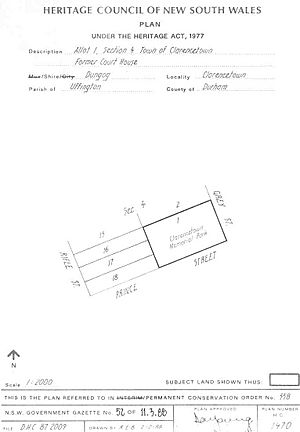Clarence Town Courthouse facts for kids
Quick facts for kids Courthouse |
|
|---|---|

Heritage boundaries
|
|
| Location | 49 Grey Street, Clarence Town, Dungog Shire, New South Wales, Australia |
| Built | 1868–1869 |
| Official name: Courthouse and site (former); Courthouse and site | |
| Type | state heritage (built) |
| Designated | 2 April 1999 |
| Reference no. | 558 |
| Type | Courthouse |
| Category | Law Enforcement |
| Lua error in Module:Location_map at line 420: attempt to index field 'wikibase' (a nil value). | |
The Clarence Town Courthouse is an old courthouse building in Clarence Town, New South Wales, Australia. It was built a long time ago, between 1868 and 1869. Today, it is a museum where you can learn about the local history. This special building is listed on the New South Wales State Heritage Register, which means it's protected for its historical importance.
Contents
History of Clarence Town
Early Days and Naming
The land where Clarence Town now stands was first home to the Wanaruah Aboriginal people. They called this area Erringhi. You can still find a hotel in town today, built in 1913, called The Erringhi Hotel.
Clarence Town is famous for building Australia's first ocean-going paddle steamer. This ship, named William IV, was launched in 1831. At that time, the town was still known as Erringhi. In 1832, the town was renamed after the Duke of Clarence. He became King William IV in 1830.
Growth as a River Port
Like many places along the Hunter, Paterson River, and Williams Rivers, Clarence Town was first visited by people cutting down timber. Land grants were given out as early as 1825. Because of its deep river access, Clarence Town became an important place. Timber and other goods could be easily transported from here.
Many landowners further up the Williams River asked for small grants in Clarence Town. They wanted to set up stores for their goods before shipping them out. Clarence Town was officially made a town in 1832. It was the third town in the Hunter area, after Newcastle and Maitland. It was planned with wide streets.
A shipbuilding industry also started here. This is where Australia's first large steamer was built. Small farms along the river and easy river transport helped the town grow quickly. Early businesses included tobacco factories and flour mills. One of the first public schools, called a National School, opened here in 1849.
Changes Over Time
Even though Clarence Town was established early and had river traffic, it didn't get public services as fast as nearby Paterson or Dungog. By the 1860s, regular coach services connected Clarence Town's steamer services with Dungog and other country towns. A new courthouse was built in 1869.
In the 1880s, many important public buildings and private homes were built in Clarence Town. During this time, fun pleasure cruises from Newcastle also started visiting. Clarence Town's decline in the 1900s is often blamed on the railway. The train line went through Dungog instead of Clarence Town. However, other things also affected the town. These included a tobacco tax, four floods, and a tough economic time in the 1890s.
Clarence Town was the main shipping hub for the area until the railway reached Dungog in 1911. Recently, the town's population has started to grow again. Many people now live in Clarence Town and travel to Newcastle for work.
The Courthouse Building
Building the Courthouse
The Clarence Town Courthouse was built between 1868 and 1869. The design of the building is thought to be by either Colonial Architect James Barnet or Mortimer William Lewis Jr. Lewis Jr was a Clerk of Works for the northern part of the Department of Public Works.
Different Uses Over Time
This building served as a courthouse for Clarence Town and the surrounding area from 1869 to 1970. After that, it became the local police station, from 1970 until 1987. In 1990, the building was changed to become the Clarence Town and District Historical Museum.
Today, the old courthouse is a local history museum. It focuses on Clarence Town's past as a river port and a place where ships could stop. The museum has many items. These include things about shipbuilding, old maps, documents, photos, and household items. You can also learn about timber-getting and farming in the area. The museum tells the story of how people settled along the Williams River.
There are also plans to create a native cottage garden. A replica pioneer settlers' cottage is also being built. This cottage will have information about the early settlers, including their names and photos. These additions will help people understand Clarence Town's history even better.
In April 2018, the local council decided to give the building to the Clarence Town Progress Association. This was because neither the council nor the museum could afford the building's upkeep. This decision brought an end to years of uncertainty about the site's future.
What the Courthouse Looks Like
The Clarence Town Courthouse is a two-story building made of timber. It is built in a style called Victorian Georgian. It has a steep, gabled roof made of corrugated galvanised iron. There is also a hipped verandah roof that is part of the main building. Next to it is an old police station and residence from the 1800s.
The courthouse looks very much like it did when it was first built. No big changes or additions have been made over the years. Inside, there are four main rooms. These include the courtroom, the police office, the magistrates' room, and some storerooms.
Heritage Status
The Clarence Town Courthouse was added to the New South Wales State Heritage Register on 2 April 1999. This means it is recognized as an important historical site.

